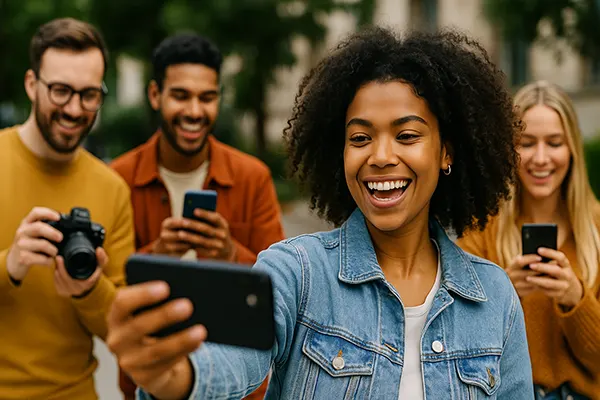
Marketing Through Audience — UGC (User-Generated Content) Strategy
User-generated content (UGC) has become one of the most effective approaches in modern marketing. In 2025, brands that succeed are those that involve their audiences directly, encouraging them to create, share, and engage with authentic materials. Unlike traditional advertising, UGC builds trust and fosters stronger connections between businesses and their communities. Below, we will explore how this strategy works, why it matters, and what trends define its use today.
The Power of User-Generated Content in Marketing
UGC serves as a bridge between brands and audiences, allowing real people to become advocates. When customers share their experiences, reviews, or creative takes on products, the message feels more authentic than branded campaigns. This authenticity is key to building credibility, particularly in highly competitive industries where traditional advertising struggles to gain trust.
Statistics show that nearly 80% of consumers in 2025 are more likely to purchase from a business when they see authentic content shared by peers. This shift means companies must create ecosystems where audiences feel motivated to contribute. From social media campaigns to interactive contests, opportunities for participation continue to grow.
For brands, UGC is not only a way to cut advertising costs but also a powerful tool for community building. It encourages loyalty, as people who contribute content often become long-term supporters of the brand. This dual effect—trust from audiences and retention from contributors—makes UGC central to many marketing strategies today.
Benefits of Integrating UGC
One of the strongest benefits of UGC is the creation of social proof. Customers trust their peers more than they trust polished advertisements. Seeing real-life experiences helps potential buyers make informed decisions and reduces uncertainty before purchasing.
UGC also improves engagement rates across digital channels. Content created by audiences often achieves higher interaction levels because it feels genuine and relatable. Brands leveraging this approach see measurable improvements in their reach and customer relationships.
Finally, UGC offers valuable insights into consumer behaviour. By analysing what people share, companies can identify preferences, spot trends, and tailor products or services to meet demand. This feedback loop gives businesses a competitive advantage in adapting quickly to market needs.
Modern Trends in UGC Strategies
In 2025, video content dominates UGC. Platforms like TikTok, Instagram Reels, and YouTube Shorts have reshaped how people communicate their experiences. Short, creative clips often reach millions within hours, making them one of the most impactful formats for brands.
Gamification has also gained momentum. By rewarding audiences for contributions, companies motivate more active participation. Loyalty points, discounts, or exclusive access encourage users to create and share more content, strengthening the relationship between brand and consumer.
Another growing trend is the use of UGC in personalisation. Brands now integrate customer-generated reviews, photos, or videos directly into their websites and product pages. This makes the shopping experience feel more personal and trustworthy, bridging the gap between digital browsing and real-world validation.
Challenges and Ethical Considerations
Despite its advantages, UGC is not without challenges. Moderation is essential, as unfiltered content may harm brand reputation. Companies must implement effective guidelines to balance creative freedom with appropriate messaging.
There are also legal considerations, particularly around ownership and consent. Brands need to obtain proper permissions before using customer content in official campaigns to avoid disputes or legal risks. Transparent communication and clear terms of use are crucial in this area.
Lastly, ethical responsibility plays a growing role. Misusing UGC or manipulating customer contributions can backfire, damaging trust. In 2025, audiences are highly aware of authenticity, and any breach of transparency can quickly spread across digital platforms, leading to reputational harm.

How to Build an Effective UGC Campaign
Successful UGC campaigns start with clear objectives. Companies must define what they want to achieve—whether it’s raising awareness, boosting sales, or increasing engagement. This clarity helps shape the strategy and choose the right tools and platforms.
Encouraging participation requires simplicity. Campaigns should be easy to join, with straightforward instructions and incentives that appeal to the target audience. Whether through hashtags, challenges, or community events, accessibility is key.
Finally, brands must showcase user contributions effectively. Highlighting the best submissions through official channels not only rewards participants but also demonstrates appreciation. This recognition motivates further involvement and deepens the emotional connection with the audience.
The Future of UGC in Marketing
Looking ahead, artificial intelligence will increasingly influence UGC. Tools for analysing trends, detecting authenticity, and personalising campaigns will allow businesses to maximise the impact of audience-created content. However, the human element of trust and creativity will remain irreplaceable.
Collaborations between brands and micro-influencers will also play a bigger role. Smaller creators with loyal communities often generate more meaningful engagement than celebrity endorsements, making them valuable partners in UGC strategies.
Ultimately, the future of marketing lies in building conversations, not just delivering messages. UGC empowers audiences to be part of these conversations, creating a cycle of trust, creativity, and growth that shapes modern brand success.
